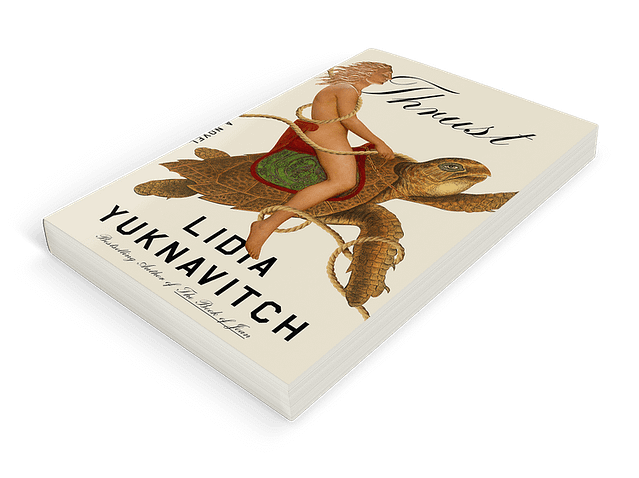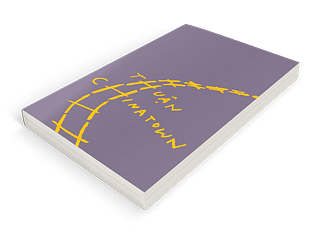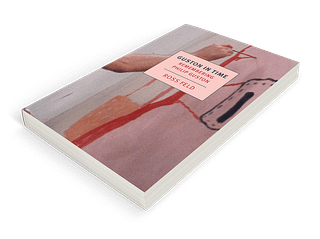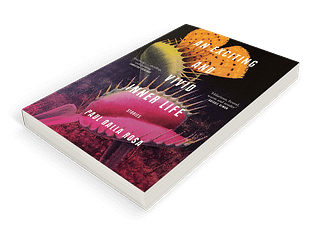
Thrust
Lidia Yuknavitch
Riverhead, $28
A good work of literature makes use of its form to teach you how to read it. Think of Tyehimba Jess’ Pulitzer Prize–winning Olio, which arranges found artifacts, song, narrative, and poems to evoke the fragmented stories of freed slaves who performed in minstrel shows, or Victoria Chang’s collection Dear Memory, where letters allow the poet to wrestle with the unanswered questions that remain after the loss of a loved one. This is also true of Lidia Yuknavitch’s most recent novel, Thrust, which combines first- and third-person narratives, ethnographic passages, and epistolary interludes to uncover the stories hidden within American history. Early in the novel, Kem, a metalsmith working on the Statue of Liberty, observes that “small cracks began to appear in the story, just as in the materials of her body and our labor.… Instead of a broken chain, she held a tablet. The tablet signified the rule of law.” The chain and shackle, meant to represent the abolition of slavery, lies beneath Liberty’s feet but is almost invisible at the base of the statue. Kem continues: “You could barely see them, but we knew they were there — our labor had put them there — and we had thoughts about it.” To seek out the cracks in the mythos of American exceptionalism and to conjure the silenced voices that lie within them is a both admirable and risky project. Thrust asks a thorny question about the purpose of a novel: what does one make of a book that teaches us how to read it so well that it reveals the limits of its own vision?
Thrust follows Laisvé, a time-traveling twelve-year-old girl coming of age in The Brook, a city resembling New York in a post-apocalyptic era several decades from the present day. Her world is a warped mirror image of our own. Pandemics have led to social collapse. Armed officers in vans conduct street raids of refugees and the rising sea level has nearly drowned the Statue of Liberty. Laisvé, whose name means “freedom” in Lithuanian, has an ability to speak to animals and a penchant for cataloguing and naming the strange objects she encounters on her adventures. Her conviction that “the right people might be in the wrong time and thus need carrying,” ferries her across time as she, according to the author’s website, “travels through water and time to rescue vulnerable figures from the margins of history.”
Thrust’s formal devices follow the pattern of Laisvé’s underwater journeys, as the novel dives into one historical moment and then surfaces at another, sifting through the detritus of the ocean floor for hidden treasures that reveals another untold story. The intricacy of the novel’s architecture rewards multiple rereadings. I first followed Laisvé, then the intertwining stories of Vera, a social worker and daughter of a war criminal, and Mikael, a traumatized and incarcerated young man who is radicalized through the letters and white supremacist ideology of Timothy McVeigh. Though the book arrived at David Chen last, he was the one I had the most difficult time letting go. Mostly because, as I realized later, part of his American experience lived inside of me.
Once a transpacific railroad worker, David finds his way to New York where he is working with a group of laborers to assemble the Statue of Liberty which has just arrived in pieces from France on the Isère, placing the action around 1885). We mostly learn about him through the observations of other characters — through Kem, a fellow laborer and David’s eventual lover, and through letters exchanged between Aurora and Frédéric Auguste Bartholdi, the French sculptor who designed the Statue of Liberty. David’s most notable feature is the hundreds of mysterious little scars that mark his skin, “white and pearled and small enough that they correspond to nothing else on this earth.” The novel hints that his scars resulted from an accident while blasting railroad tunnels. Though David “rarely speaks,” his body seems to speak for him, most often when he is asleep as those around him try to decipher the stories his scars tell. In this way David is both hyper-visible and invisible at the same time.
In many ways, this rendering felt true to life, in that to be nonwhite, for most of modern history, has meant to be both overlooked and scrutinized. And yet at times Yuknavitch’s narrativizing of these poles can feel exaggerated, almost dramatic. Perhaps I noticed it most with David because, as an Asian American, I felt a certain recognition. Was the hint of caricature also on the page for the other characters? Aurora describes David’s skin as “a color between white and wheat.” (Why are the skin tones of nonwhite characters still being described using the language of food?) Almost white, but not quite. Familiar, somehow, but different enough to be “exotic.” I tug at that feeling and it unravels into worlds.
Thrust’s vision of a shared future that “will be made of stories connecting all forms of existence” as a narrator comments in one of the last chapters, is a beautiful, hopeful one, but what happens when the interconnection of these stories, instead of offering insight or clarity into painful subjects, merely reopen wounds, grief, and shame? What if what one audience sees as the “scars of the past” are still open wounds to those communities who bear the marks of this country’s violence on their bodies now? For some, David’s scarring might be a sign of survival; but for me, it is inextricably tied to the history of the gazes that have framed the realities of Asian Americans in this country for centuries. Of the gazes that would seek to fetishize or commodify Asian bodies and the ways that orientalist tropes of Asian immigrants as dirty and disease ridden have led to increased xenophobia and violence against Asians during the COVID-19 pandemic. Of the sexualized stereotypes of Asian bodies as exotic and submissive that contributed to the Atlanta spa shootings. Of the desire around Asian bodies, as laborers, as sexual objects, that has been a part of American history for centuries. How this country has often wanted us, in a way, but conditionally, and never too close.
All these strands wound tight around me as I read Kem imagining the scars on the sleeping David transforming him into “a great crane,” and confessing his longing: “I wanted to crawl onto his cot and cup his body with my body, like a double parenthesis, something held inside another, where no one anywhere could find us. I want to push my cock into him I want to tendril my arm around to his waist to the velvet pulse of his cock I want to hold him and work the desire out of him in a rush.” Accompanying this longing is Kem’s desire for David to stay turned away in sleep: “so that all there is of him is his back, the hieroglyphics writing the unsaid story of whatever happened to him, his back the new world. If he stays turned away from me, if he stays asleep, nothing and no one can ever take my love for him away. There is another kind of freedom in that.” There is a freedom there, but whose is it?
It is difficult not to hear the colonial impulse, a mixed metaphor that bridges Orientalist fantasies of Egypt in the European and American imagination to the vision of America as a sleeping, untouched land. Later in the scene, Laisvé visits Kem and gives him a coiled white rope that she explains is kinbaku, used in a Japanese style of sexual bondage that draws on hojojutsu, a practice of binding prisoners of war for execution. The rope then leads both Kem and David to Aurora’s boardinghouse where David hangs for many hours, “a man moving through torture to tenderness, suspended from thick ropes made from the silk of spiders.” I suspect the rope is meant to be a symbol of transformation: the device which signified his lowering into the railroad tunnels changed to a form of deliverance that raises him to work inside the crown of the Statue of Liberty, and into a source of cathartic, erotic agency that enables him to “touch something he has lost.” It’s exactly Yuknavitch’s usual deft handling of images and their consequences that makes a scene like this so bewildering. There is obvious risk in taking an image so closely tied to a particular kind of violence and sexualized tropes and repurpose it. When the risk pays off, the image convincingly completes its metamorphosis, and creates something new. But when it fails, the weight of association is so heavy that the image feels much more a reminder of trauma than an agent of transformation. Kem seems likely meant to be Black (he mentions his home country of Saint-Domingue and his father and grandfather moving through stories of slavery) but still, the narrative voice that seizes upon these colonial images seems to replicate the desire of empire rather than refuse it.
In her acknowledgements, Yuknavitch writes that her hope is that “the plurality of voice, body, and experience especially available in the form of the novel might serve to keep the tensions, contradictions, conflicts, and desires of the many rather than the one alive, noisy, unflinching.” She also comments that she attempts to use the novel’s reimagined ethnographies “to agitate the form of the novel” by amplifying Bakhtin’s concept of “heteroglossia.” The book succeeds a great deal on this front, and the pains the author takes to represent accurately the stories Thrust draws upon is evident through her extensive research of primary and secondary sources about the people and eras the novel concerns. But, as she also acknowledges, there are “unintentional distances” that “exist in any human interaction that leads to bearing witness or representing the experiences of others.” Before we can create the cacophonous, polyvocal future that Thrust envisions, perhaps we must recognize how sometimes truly vast those “unintentional distances” are. That throughout history, those “unintentional distances” themselves have occasionally contributed to the silencing of certain stories.
Thrust reflects the complexities of the novel as form and the story of its own becoming. Edward Said, for one, noted how imperialism and narrative authority are intertwined: “Without empire, I would go so far as saying, there is no European novel as we know it…” This underscores the fact that the stories that connect us also tie us to the histories that gave rise to our literary forms. And these stories continue to live inside us. Even as we aspire to write against the terrors and silences that have seeped into our history, they remain with us, embedded in the very syntax and vocabulary of the worlds which we try to re-envision. What could a truly polyvocal future look like?
Leah Silvieus is a poet and writer. Her most recent poetry collection is Arabilis.


